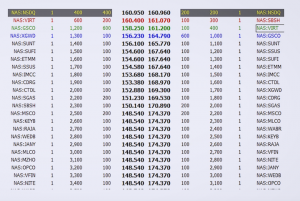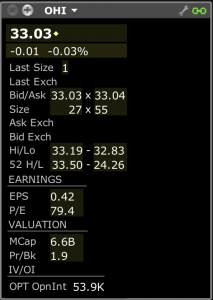An often under-appreciated subset of technical analysis, called Level II market data, can be highly useful for traders. Level II market data shows a broader range of market orders outside of basic bid, ask, and market prices. Namely, it extends on the information available in the Level I variety.
So what are level II quotes?…
Level II data is also known as “market depth” by showing the number of shares, contracts, or lots available at each individual price.
In addition, it is commonly referred to as the order book, given it shows a range of orders that have been placed and are waiting to be filled. Orders are filled whenever buyers and sellers in the market agree to transact at a given price.
Level I Market Data
Level I data includes the following:
Bid price: The highest price a market participant is willing to buy an asset or security at.
Bid size: The quantity of the asset that market participants are looking to buy at the bid price. This can include the number of shares (e.g., stocks), contracts (e.g., futures), or lots (e.g., forex). Sometimes this number is divided by 100 (and sometimes a different figure) simply to shorten the number of digits that need to be used.
Ask price (also known as the offer price): The lowest price a market participant is willing to sell an asset or security at.
Ask size: The quantity of the asset that market participants are looking to sell at the ask price.
This can include the number of shares, contracts, or lots.
Market price (sometimes last price): The price at which the last trade settled.
Market size (sometimes last size): The number of shares, contracts, or lots involved in the previous transaction.
Traditional technical analysis, which involves trading based on price action or indicators that involve transformations of price and/or volume, relies on Level I data.
Standard Level I data can typically be viewed within your broker. For example, here is Level I data on Google (GOOG) stock:

This shows the bid, ask, current market price, current size (bid and ask size both approximate 200 shares, as denoted by the “2×2”)
Level II Market Data (Market Depth / Order Book)
Level II data includes multiple bid and ask/offer prices. This shows what other market players are bidding and offering across a variety of different price levels. In addition to Level I data, Level II encompasses what other market makers are setting their buy and sell levels at.
What are market makers? They are securities or assets dealers who provide liquidity to the market by being willing to buy and sell at specific prices at all times.
For most traders, Level I data will be available to you through your broker.
And often, but not always, for free.
For those who depend on more in-depth data, such as what kind of order size is located at what prices, they will need to have Level II data. This is often provided by brokers at a charge. It may be free or it may not be available on some brokerages altogether. Level II data is generally more expensive than Level I data on stock and futures trading platforms. It is regularly free on many forex brokers.
For an example of the difference between Level I and Level II data, let’s say you’re trading a stock with a market price of $25.00; the bid is $24.98 and the ask is $25.02. This is standard Level I data.
Level II would include a list of bid and ask prices up and down the ladder. For instance, you might see bid prices at $24.95 and $24.92 with more size than you see at the regular Level I bid and ask prices at $25.05 and $25.08. Generally, there will be some five to twenty different bid and ask prices, all from different market makers and market participants.
What Are Level II Quotes?
Below is a list of the information included in Level II data:
Multiple bid prices: Level II data encompasses the bid from Level I data as well as all other bid prices below this figure. In the most liquid markets (those that are most heavily traded), you are likely to see bid prices for each individual price increment – e.g., for each $0.01 in a large cap stock.
If assets or securities have large bid/ask spreads – i.e., the difference between the bid and ask is 0.1% or more the price of the security – they are also likely to have sizable gaps in the bid and ask spreads in the market depth data.
Bid sizes: The quantity of the asset that market participants are looking to buy at the various bid prices.
Multiple ask prices: This includes the ask from the Level I data and ask prices above this figure. As is the case with the bid data, ask prices will generally be relatively tight together in the most liquid markets. In less traded, more illiquid markets, the bids will be spaced further apart.
Ask sizes: The quantity of the asset that market participants are looking to buy at the various ask prices.
Example of Level II Market Data
This shows an example of Level II data for a NASDAQ stock:

The very top of the chart show the bid (160.950) and ask (160.960) prices, or standard Level I data.
Level II data includes the bids all the way down on the centre left-hand column and the asks all the way down on the centre right-hand column.
To the immediate left of the bid prices (column starting with 160.950) is the size, or number of shares, being offered at that level.
The next column over is the cumulative size.
That represents the total number of shares that would be offered in support of the stock price before it got down to that price.
The same is done over on the ask side (the right-hand side).
The very far left and right columns represent different market makers.
Many traders like looking at the cumulative number of shares being offered at each level. If there is an imbalance, that may denote which side the market is leaning toward with respect to a particular security or asset. Traders may also look at the size being offered at the bid and ask to obtain a general understanding of where the market is likely to head.
In this particular example, there are more shares being offered on the ask side (left-hand side), denoting that buyers are, in effect, more powerful than sellers. Accordingly, this might inform a trader of a bullish bias insofar as the Level II data / order book wager into the decision-making process.
In terms of further examples, but relying on Level I data alone, below we see a Ford (F) bond where the size is $80K at the bid and $3K at the ask. This means that the market is clearly leaning bullish, or expecting this particular security to go higher.

We see the same on the following Petrobras (PETBRA) bond where the size is $250K at the bid and $155K at the ask.
Bid outweighing the ask represents a bullish market.

On Omega Healthcare Investors (OHI) stock you can see about twice as much size at the ask than the bid.This denotes a more bearish slant.

Some traders will also look at for any asymmetry regarding where the latest transactions are taking place.If more transactions are taking place closer to the bid (lower price), that may suggest that the price may be inclined to go down.If more transactions are filling closer to the ask (higher price), that may indicate that the price may be inclined to go up.
None of this, of course, is fool proof.Orders may come in at any time to influence a market’s direction.
Conclusion
Level II market data, also known as “market depth” and the order book, look at bid and ask prices and sizes beyond the bid and ask prices nearest the market price in Level I data.
Day traders may receive both Level I and Level II market data through their brokerage.Level II data should be available for stocks and futures trading.However, there may be an additional charge for this.Some provide Level I and Level II data for free, but may compensate by charging higher commissions per trade.
Many forex brokers offer Level II market data, but some do not.
